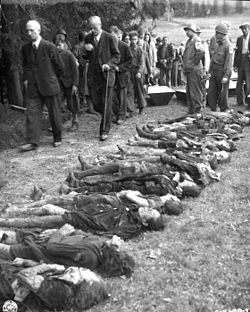死亡行军
外观

死亡行军(英语:death march)是一个针对战俘或其他俘虏或被驱逐出境者的强迫行军[1],这与通过徒步行军运送囚犯的简单方式不同。死亡行军通常包含严苛的体力劳动和虐待、忽视囚犯的伤病,故意使俘虏饥饿和缺水而死,受到屈辱和酷刑,并处死那些无力跟上步伐的人。死亡行军最终可能会结束在一个战俘营或拘留营,或者也可能会继续下去,直到所有的囚犯都死了(如在亚美尼亚种族灭绝的情况)。
例子
[编辑]第二次世界大战之前
[编辑]We passed a slave woman shot or stabbed through the body and lying on the path. [Onlookers] said an Arab who passed early that morning had done it in anger at losing the price he had given for her, because she was unable to walk any longer.[3]
- 作为印第安人迁移政策的一部分,在美国,1831年,大约6000名乔克托族人被迫离开密西西比州,前往奥克拉荷马州,他们只有大约4000人在1832年抵达该地。[4]
- 1836年,在克里克战争后,美国陆军自阿拉巴马州将2500名马斯科吉人(Muscogee)作为战俘驱逐出境。[5]其余的部落成员(12 000人)紧随其后,同样被军队驱逐出境。 在抵达俄克拉何马州的时候,已有3500人死于感染。[6]
- 1838年,总统安德鲁·杰克逊下命令迫使切罗基人西行前往奥克拉荷马。成为众所周知的血泪之路:估计有4 000名男人、妇女和儿童死于途中。[7]
- 在1915至1918年间造成多达1,500,000人的亚美尼亚种族灭绝事件。在以第一次世界大战为借口的掩饰下,青年土耳其党人试图清洗鄂图曼土耳其的亚美尼亚人口。结果,大部分亚美尼亚人口被迫从西亚美尼亚流放到叙利亚沙漠。[8]许多人在他们前往在叙利亚的沙漠的25个集中营的途中惨被强奸、遭受酷刑,并被杀害。在最恶名昭彰的营地, 德佐尔那里估计有300 000名亚美尼亚人被杀。[9]


第二次世界大战期间
[编辑]在第二次世界大战期间,战俘的死亡行军出现在纳粹德国占领下的欧洲和大日本帝国。随著盟军在占领欧洲的过程中逼近集中营,在后期阶段的犹太人大屠杀中犹太人的死亡行军变得常见。
- 在巴巴罗萨行动中,特别是在1941年至42年期间,当大量苏联军人被俘虏的时候,死亡行军就成为一种德国虐待苏维埃战俘的形式,被认为是[谁?]一个德国犯下的战争罪行。
- 1943年二月,斯大林格勒战役后,许多德国战俘在行进中被撇在路上死去。[10]在一开始在斯大林格勒附近的关押后,他们被送到一场“穿越结冻草原的死亡行军”,前往位于苏联某处的劳改营。[11]
- 在 太平洋战区,日本帝国陆军对盟军战俘多次实行死亡行军,包括臭名昭着的 巴丹死亡行军 (1942年)和 山打根死亡行军 (1945年)。前者强行转移60-80,000名战俘至巴朗牙、造成2 500–10,000名菲律宾人和100-650名美国人死亡,而后者则造成2,345名澳大利亚和英国人死去,其中只有6人幸存。巴丹和山打根的死亡行军都被判定为战争罪。
- “死亡行军”一词被受害者,然后由历史学家用来称呼在 第二次世界大战 历史的背景下,1944年秋天至1945年四月纳粹德国 将他们成千上万的战俘从不断推进的战线附近的纳粹集中营强迫转移到德国境内的营地。其中一场臭名昭着的死亡行军发生在1945年一月,因为苏联红军不断在被占领的波兰中推进。在苏军抵达奥斯威辛集中营的九天前,SS 将近60000名囚犯从营地押往有35英里之遥的希隆斯克地区沃济斯瓦夫,在那里他们会被货运火车运到其他集中营。大约15000名囚犯在途中死亡。[12][13]
第二次世界大战之后与冷战时期
[编辑]- 1945年的布莱堡遣返 (发生于二战最后的日子和之后),有约280,000名克罗埃西亚人参与,[14]他们绝大多数都是平民和克罗地亚国土保卫军成员,被迫行军经过波士尼亚与赫塞哥维纳,克罗埃西亚,斯洛文尼亚至到奥地利,但英军在那里把他们交给南斯拉夫人民解放军。于是他们得再次返回克罗埃西亚,波士尼亚与赫塞哥维纳甚至是马其顿共和国。[15]
- 第一次中东战争期间,70,000名来自卢德和拉姆拉的巴勒斯坦人和阿拉伯人被以色列军强行驱逐。这次事件以卢德死亡行军而为人所知。[16]
- 在韩战的时候北韩拘押的战俘经历到后来被称为“老虎死亡行军”的遭遇。这场行军发生在联合国军队推进北韩国境的时候。北韩势力撤退到在中朝边境的鸭绿江,同时也携带上他们的犯人。 在1950年10月31日 大约845名犯人,包括大约80名非作战人员,离开满浦沿河而上,在同年11月8日到达中江。一年之后,少于300人依然生还。这场强行军因一名负责此事而残忍的北韩上校的绰号“老虎”得名。在犯人当中有一名名为乔治·布莱克的军官。在他被囚期间,受朝鲜影响成为一位KGB双重间谍。[17]
- 柬埔寨红色高棉在1975年针对金边人口进行的强制迁移。
参考文献
[编辑]- ^ 存档副本. [2018-08-09]. (原始内容存档于2021-03-08).
- ^ Convention (IV) relative to the Protection of Civilian Persons in Time of War. International Committee of the Red Cross. International Committee of the Red Cross. 1949-08-12 [2014-04-24]. (原始内容存档于2016-05-18).
- ^ Livingstone, David. The Last Journals of David Livingstone, in Central Africa, from 1865 to His Death. Echo Library. 2006: 46 [2018-08-09]. ISBN 1-84637-555-X. (原始内容存档于2019-06-12).
- ^ Trail of Tears. (原始内容存档于2016-03-12).
- ^ Foreman, Grant. Indian Removal: The Emigration of the Five Civilized Tribes of Indians. University of Oklahoma Press. 1974 [1932]. (原始内容存档于2012-04-13).
- ^ Creeks. [2018-08-09]. (原始内容存档于2018-11-16).
- ^ Marshall, Ian. Story line: exploring the literature of the Appalachian Trail Illustrated. University of Virginia Press. 1998 [2018-08-09]. ISBN 978-0-8139-1798-6. (原始内容存档于2019-06-10).
- ^ Exiled Armenians Starve in the Desert. The New York Times (Boston). 1916-08-08 [2018-08-09]. (原始内容存档于2012-02-02).
- ^ 存档副本. [2018-08-09]. (原始内容存档于2016-05-16).
- ^ Beevor, Antony. 25 The Sword of Stalingrad. Stalingrad. London: Viking. 1998. ISBN 978-0-14-103240-5.
- ^ Griess, Thomas E. The Second World War: Europe and the Mediterranean (The West Point Military History Series). West Point Military Series; First Printing edition. 2002: 134. ISBN 978-0757001604.
- ^ Death marches. (原始内容存档于2009-08-25).
- ^ Gilbert, Martin. Atlas of the Holocaust Revised and Updated. William Morrow & Company. May 1993. ISBN 0688123643. (map of forced marches)
- ^ Corsellis, John, & Marcus Ferrar. 2005. Slovenia 1945: Memories of Death and Survival After World War II. London: I.B. Tauris, p. 204.
- ^ Vuletić, Dominik. Kaznenopravni i povijesni aspekti bleiburškog zločina. Lawyer (Zagreb, Croatia: Pravnik). December 2007, 41 (85): 125–150 [2015-03-24]. ISSN 0352-342X. (原始内容存档于2018-05-07) (克罗地亚语).
- ^ Holmes, Richard; Strachan, Hew; Bellamy, Chris; Bicheno, Hugh. The Oxford companion to military history Illustrated. Oxford University Press. 2001: 64. ISBN 9780198662099.
On 12 July, the Arab inhabitants of the Lydda-Ramle area, amounting to some 70,000, were expelled in what became known as the 'Lydda Death March'.
- ^ Lewis H Carlson. Remembered Prisoners of a Forgotten War: An Oral History of Korean War POWs. St Martin's Press. 2002: 49–50, 60–62. ISBN 0-312-28684-8.
